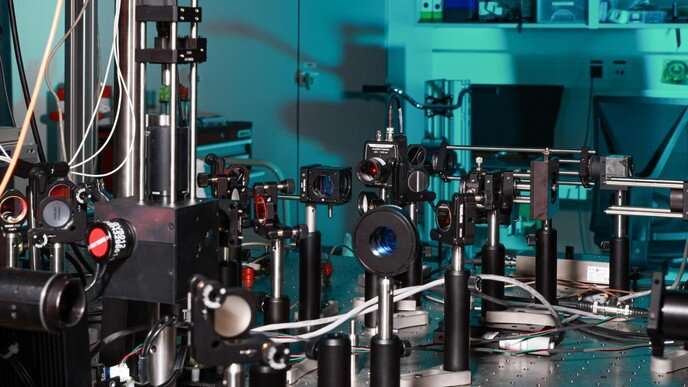This article has been reviewed according to Science X's editorial process and policies. Editors have highlighted the following attributes while ensuring the content's credibility:
fact-checked
peer-reviewed publication
trusted source
proofread
Electrical control of hybrid exciton transport in a van der Waals heterostructure

EPFL engineers have found a way to control the interactions between excitons—quasiparticles that may one day transport data and replace the electrons in electronic devices. The engineers' method involves applying an electric field to a two-dimensional (2D) semiconducting material. Their findings appear in Nature Photonics.
Electronic devices have become an essential feature of just about all aspects of modern society. Yet, due in part to the growing use of the internet, they're bumping up against their limits in terms of processing speed and miniaturization. What's more, they consume vast amounts of energy in transporting and storing information, losing some of that energy as they go. Engineers—including those at EPFL—have been working for years to overcome these obstacles, such as by studying excitons and their behavior in 2D materials.
Excitons are made up of an electron (which has a negative charge) and a hole (which has a positive charge). They hold the key to the next generation of electronic devices—ones that are smaller and faster and result in much less power loss. With excitons, which can either replace or work with electrons, it's light rather than electricity that carries data and runs calculations.
"Light is already used in fiber optics," says Fedele Tagarelli, a Ph.D. student at EPFL's Laboratory of Nanoscale Electronics and Structures (LANES), headed by Prof. Andras Kis. "Although light is widely used to transport information, light-based computing systems have been hindered by materials limitations and scalability issues."
Edoardo Lopriore, another Ph.D. student at LANES, explains, "Excitons, unlike electrons, could cause much less heating when moving through a material and work very well with light. But to leverage their full potential, we need to be able to understand and control how they're generated and interact with each other, along with their speed and life span. All this is still in the research stage." Under ideal conditions, excitons can reach a superfluid state, meaning they can travel without energy or resistance—and therefore without any power loss.
Repulsive force
Engineers at LANES, together with colleagues at the University of Marburg in Germany and the National Institute for Materials Science in Japan, have looked specifically at one key property of excitons: the repulsive force between them. They developed a testing system comprised of several layers of different materials. The top and bottom layers are made of metal, while the middle section consists of an insulating material and layers of a semiconducting 2D material—in this case, tungsten diselenide (WSe2)—stacked on top of each other and bound together by van der Waals forces. 2D materials have the unique feature of being extremely thin—just a single layer of atoms. "They have completely different properties from 3D materials and let us explore new physics phenomena," says Tagarelli.
The engineers applied an electric field to their device and found they could control the excitons' repulsive interactions. "As far as we know, this is the first time such control has been demonstrated, or at least in such a simple way," says Tagarelli. "We've discovered a new method for controlling interactions between hybrid excitons, which can provide a unique opportunity for studies in condensed matter physics." In a previous study, LANES engineers succeeded in controlling the life span and movements of excitons.
For the engineers' method to work, the excitons shouldn't be directly subjected to an electric current but rather be able to "sense" an electric field—hence the outer metal layers and inner insulating layer to protect the semiconducting 2D material. The engineers' experiments were run at the extremely low temperature of 4 Kelvin.
"This discovery further expands our toolkit for controlling excitons so that they can one day be used to process data in a more environmentally responsible way," says Kis.
More information: Fedele Tagarelli et al, Electrical control of hybrid exciton transport in a van der Waals heterostructure, Nature Photonics (2023). DOI: 10.1038/s41566-023-01198-w
Journal information: Nature Photonics
Provided by Ecole Polytechnique Federale de Lausanne




















